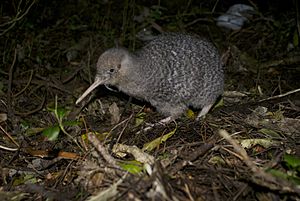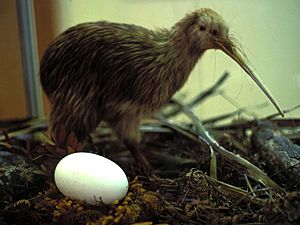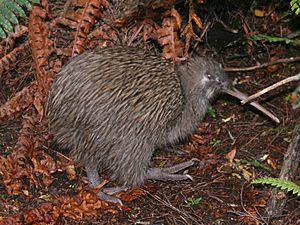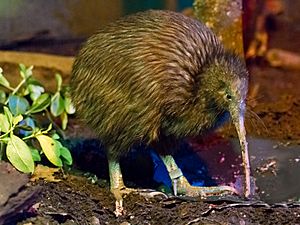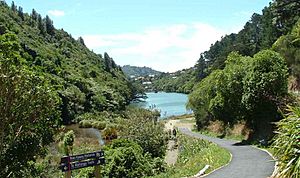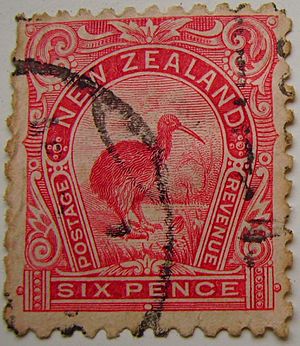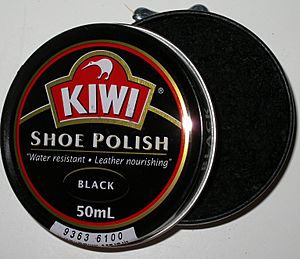Kiwi facts for kids
Quick facts for kids Kiwi |
|
|---|---|
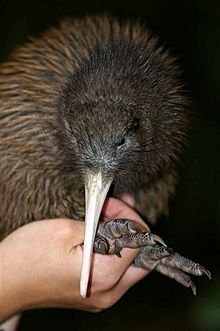 |
|
| Scientific classification | |
| Kingdom: | |
| Phylum: | |
| Class: | |
| Order: |
Struthioniformes
|
| Family: |
Apterygidae
G.R. Gray, 1840
|
| Genus: |
Apteryx
Shaw, 1813
|
The kiwi is a special flightless bird that lives only in New Zealand. It's about the size of a domestic chicken. Kiwis are the smallest of a group of large flightless birds called ratites. This group also includes ostriches, emus, and cassowaries.
Scientists have found that kiwis are related to the huge, extinct elephant birds from Madagascar. There are five types of kiwi, and most of them are in danger of disappearing. All kiwi species have been affected by forests being cut down in the past. But now, their forest homes are protected in special reserves and national parks.
A kiwi's egg is one of the biggest eggs for its body size of any bird in the world. It can be up to 20% of the female's weight! Kiwis also have other unique features. They have feathers that look like hair, short strong legs, and long beaks. They use their nostrils at the end of their beak to sniff out food without even seeing it. These special features have made the kiwi famous around the world.
The kiwi is a very important symbol of New Zealand. People often call New Zealanders "Kiwis" because of this strong connection. In 2019, it was estimated that only about 68,000 kiwis were left in the wild.
Contents
Different Kinds of Kiwi
There are five main types of kiwi, plus some smaller groups within those types.
| Image | Scientific name | Common Name | Where They Live | What They Look Like |
|---|---|---|---|---|
 |
Apteryx haastii | great spotted kiwi or Roroa | New Zealand | This is the largest kiwi. It stands about 45 cm (18 in) tall and weighs around 3.3 kg (7.3 lb). It has grey-brown feathers with lighter stripes. The female lays one egg, and both parents help hatch it. Over 20,000 of these kiwis live in the mountains of Nelson and the Southern Alps. |
 |
Apteryx owenii | little spotted kiwi | Kapiti Island | This small kiwi is about 25 cm (10 in) tall and weighs about 1.3 kg (2.9 lb). It couldn't survive attacks from animals like pigs and cats on the mainland. Now, about 1350 live on Kapiti Island. They have also been moved to other islands where there are no predators. The male kiwi hatches the single egg. |
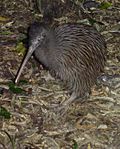 |
Apteryx rowi | Okarito kiwi, the rowi, or Okarito brown kiwi | South Island | This kiwi was identified as a new species in 1994. It's a bit smaller than other kiwis and has grayish feathers. Females can lay up to three eggs in a season, each in a different nest. Both parents help hatch the eggs. These kiwis live in a small area on the west coast of the South Island. |
 |
Apteryx australis | southern brown kiwi, Tokoeka, or Common kiwi | South Island | This kiwi is quite common and looks similar to the brown kiwi, but its feathers are lighter. There are several types of Tokoeka:
|
 |
Apteryx mantelli or Apteryx australis | North Island brown kiwi | North Island | This is the most common kiwi, with about 35,000 left. Females are about 40 cm (16 in) tall and weigh around 2.8 kg (6.2 lb). This kiwi is very tough and can live in many different places, even in non-native forests. Its feathers are streaky red-brown. The female usually lays two eggs, which the male hatches. |
Kiwi Life and Habits
Kiwis are night birds. This means they are active mostly after the sun goes down. They mainly eat small creatures like worms and insects. Kiwis usually live alone or with their partner in a special area called a territory. In their territory, they build several small burrows or caves where they sleep and lay their eggs.
Kiwis are monogamous. This means a male and female kiwi stay together as a pair for their whole lives, until one of them dies. They live in the same territory and work together to raise their young.
Female kiwis lay 1 to 3 eggs. Kiwis become adults when they are about 2 years old. They can live for more than 20 years. One kiwi in a zoo even lived to be 35 years old!
A kiwi's eyes are very small compared to its body. They don't see very well, especially in the dark. Kiwis rely much more on their other senses. They have amazing hearing, a fantastic sense of smell, and can feel things around them. Their eyesight is so weak that blind kiwis have been found in nature. This shows how little they depend on their vision to survive and find food.
All About Kiwi Eggs
The female brown kiwi lays huge eggs. These eggs can be almost one-sixth of her own body weight! It takes a very long time for kiwi eggs to hatch, about 11 weeks. This is the longest incubation time for any bird. For example, Yellow-breasted Chats' eggs hatch in only 11 days, and chickens' eggs take 21 days.
Where Kiwis Live
Kiwis like to live in burrows they dig in forests. They make their burrows in the ground, like rabbits do. They also find homes between tree roots or inside hollow logs. Kiwis make their burrows cozy and warm by lining them with leaves. Sometimes, they even hide the entrance to their burrows with piles of twigs. A kiwi might have more than ten different burrows in its territory and will switch between them sometimes.
Sadly, kiwis are in danger from many mammals that were brought to New Zealand. Stoats are the biggest threat to young kiwi chicks. Ferrets and dogs can kill adult kiwis.
Protecting Kiwis: Sanctuaries
In 2000, the New Zealand Department of Conservation created five special kiwi sanctuaries. These places focus on finding ways to protect kiwis and help their numbers grow. There are three kiwi sanctuaries in the North Island and two in the South Island:
- Whangarei Kiwi Sanctuary (for Northland brown kiwi)
- Moehau Kiwi Sanctuary on the Coromandel Peninsula (Coromandel brown kiwi)
- Tongariro Kiwi Sanctuary near Taupo (western brown kiwi)
- Okarito Kiwi Sanctuary (Okarito kiwi)
- Haast Kiwi Sanctuary (Haast tokoeka)
Many other protected areas and fenced sanctuaries also have many kiwis, including:
- Zealandia fenced sanctuary in Wellington (little spotted kiwi)
- Maungatautari Restoration Project in Waikato (brown kiwi)
- Bushy Park Forest Reserve near Kai Iwi, Whanganui (brown kiwi)
- Otanewainuku Forest in the Bay of Plenty (brown kiwi)
- Hurunui Mainland Island, North Canterbury (great spotted kiwi)
North Island brown kiwis were also moved to the Cape Sanctuary in Hawke's Bay between 2008 and 2011. Chicks raised there were then released into the Maungataniwha Native Forest.
Kiwis in Zoos
In 1851, the London Zoo was the first zoo to have a kiwi. The first time kiwis were successfully bred in a zoo was in 1945. As of 2007, only 13 zoos outside New Zealand have kiwis. Some of these include the Frankfurt Zoo, Berlin Zoo, San Diego Zoo, and the National Zoo in Washington, DC.
Kiwi: A National Symbol
The kiwi first became a symbol in the late 1800s. It appeared on military badges in New Zealand. In 1906, when Kiwi Shoe Polish became popular in the UK and US, the kiwi symbol became even more widely known.
During the First World War, New Zealand soldiers were often called "kiwis." A huge kiwi was even carved into a chalk hill in England, which is now known as the Bulford kiwi. Today, the name "Kiwis" is used for all New Zealanders, both at home and abroad.
The kiwi is now the most famous national symbol for New Zealand. You can see the bird on the country's coat of arms, and on the badges of many New Zealand cities, clubs, and groups. A red kiwi shape is also in the middle of the roundel (a circular emblem) of the Royal New Zealand Air Force.
The kiwi is part of the logo for the New Zealand Rugby League. The New Zealand national rugby league team is even nicknamed the Kiwis.
An image of a kiwi is on the back of the New Zealand dollar coin. In money trading, the New Zealand dollar is often simply called "the kiwi."
Māori and the Kiwi
The Māori people traditionally believed that kiwis were protected by Tane Mahuta, the god of the forest. They used kiwis for food, and their feathers were used to make special ceremonial cloaks called kahu kiwi. Today, kiwi feathers are still used for these cloaks. However, the feathers are now collected from birds that have died naturally, from accidents, or from kiwis in captivity. Kiwis are no longer hunted, and some Māori people see themselves as the birds' guardians.
Images for kids
See also
 In Spanish: Kiwi (desambiguación) para niños
In Spanish: Kiwi (desambiguación) para niños


